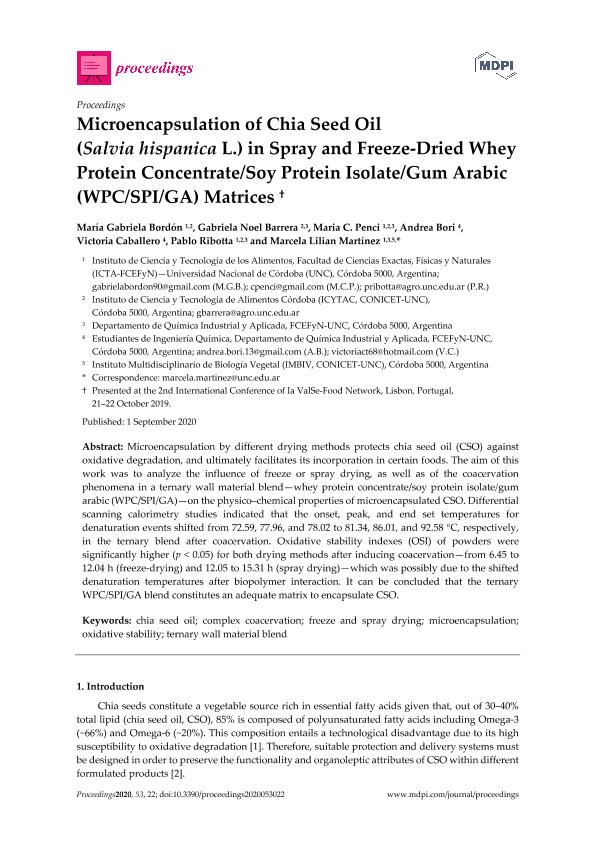Artículo
Microencapsulation of chia seed oil (Salvia hispanica L.) in spray and freeze-dried whey protein concentrate/soy protein isolate/gum arabic (WPC/SPI/GA) matrices
Bordón, María Gabriela ; Barrera, Gabriela
; Barrera, Gabriela ; Penci, Maria Cecilia
; Penci, Maria Cecilia ; Bori, Andrea; Caballero, Victoria; Ribotta, Pablo Daniel
; Bori, Andrea; Caballero, Victoria; Ribotta, Pablo Daniel ; Martinez, Marcela Lilian
; Martinez, Marcela Lilian
 ; Barrera, Gabriela
; Barrera, Gabriela ; Penci, Maria Cecilia
; Penci, Maria Cecilia ; Bori, Andrea; Caballero, Victoria; Ribotta, Pablo Daniel
; Bori, Andrea; Caballero, Victoria; Ribotta, Pablo Daniel ; Martinez, Marcela Lilian
; Martinez, Marcela Lilian
Fecha de publicación:
01/09/2020
Editorial:
MDPI
Revista:
Proceedings
e-ISSN:
2504-3900
Idioma:
Inglés
Tipo de recurso:
Artículo publicado
Clasificación temática:
Resumen
Microencapsulation by different drying methods protects chia seed oil (CSO) against oxidative degradation, and ultimately facilitates its incorporation in certain foods. The aim of this work was to analyze the influence of freeze or spray drying, as well as of the coacervation phenomena in a ternary wall material blend whey protein concentrate/soy protein isolate/gum arabic (WPC/SPI/GA)?on the physico?chemical properties of microencapsulated CSO. Differential scanning calorimetry studies indicated that the onset, peak, and end set temperatures for denaturation events shifted from 72.59, 77.96, and 78.02 to 81.34, 86.01, and 92.58 °C, respectively, in the ternary blend after coacervation. Oxidative stability indexes (OSI) of powders were significantly higher (p < 0.05) for both drying methods after inducing coacervation?from 6.45 to 12.04 h (freeze-drying) and 12.05 to 15.31 h (spray drying)?which was possibly due to the shifted denaturation temperatures after biopolymer interaction. It can be concluded that the ternary WPC/SPI/GA blend constitutes an adequate matrix to encapsulate CSO.
Archivos asociados
Licencia
Identificadores
Colecciones
Articulos(ICYTAC)
Articulos de INST. DE CIENCIA Y TECNOLOGIA DE ALIMENTOS CORDOBA
Articulos de INST. DE CIENCIA Y TECNOLOGIA DE ALIMENTOS CORDOBA
Citación
Bordón, María Gabriela; Barrera, Gabriela; Penci, Maria Cecilia; Bori, Andrea; Caballero, Victoria; et al.; Microencapsulation of chia seed oil (Salvia hispanica L.) in spray and freeze-dried whey protein concentrate/soy protein isolate/gum arabic (WPC/SPI/GA) matrices; MDPI; Proceedings; 53; 1; 1-9-2020; 1-6
Compartir
Altmétricas



